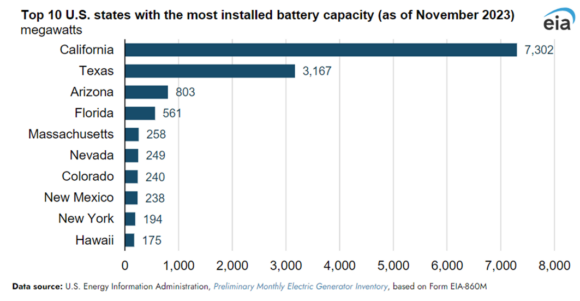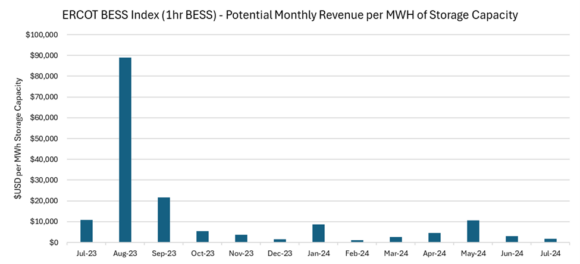Battery Energy Storage Systems (BESS) development has been looming in U.S. energy markets for several years. Now, as capacity has begun expanding rapidly, the insurance claims are beginning to materialize in both construction and operational policies.
For underwriters and claims professionals interested in learning about BESS importance, functionality, features, monetization and key considerations, the following information may be of help when answering questions including, but not limited to:
- What does the future of energy storage look like?
- How are Battery Energy Storage Systems monetized?
- What are Battery Energy Storage Systems used for?
- How to estimate exposure for Battery Energy Storage System?
BESS Market Growth


In the rapidly evolving landscape of energy, BESS are finally coming to the forefront of US energy markets.
By the end of 2024, the U.S. Energy Information Administration expects that BESS capacity will exceed 30 GW. That growth represents a five-fold increase in a four-year period. Much of the current and future growth has been fueled by the passage of the 2022 Inflation Reduction Act (IRA).
Prior to the IRA, BESS projects only qualified for the lucrative Investment Tax Credit (ITC) program if the system met several criteria; most notably, the system was required to be built in conjunction with a solar facility (“co-located”) and was required to be charged by 100% renewable energy sources.
 These limitations led to a lag in US BESS development. However, the IRA removed both of those hurdles, and now much of the BESS capacity coming online are stand-alone facilities and can be charged from any source of power and still qualify for ITC benefits. As a result, there has been an increase in available BESS investment capital in the form of increased tax equity market participation, the long-standing driving force behind US Renewable Energy.
These limitations led to a lag in US BESS development. However, the IRA removed both of those hurdles, and now much of the BESS capacity coming online are stand-alone facilities and can be charged from any source of power and still qualify for ITC benefits. As a result, there has been an increase in available BESS investment capital in the form of increased tax equity market participation, the long-standing driving force behind US Renewable Energy.
In terms of location, an overwhelming majority of the currently installed and planned BESS capacity in the US is in two quite different regional Independent System Operators (ISO)—Texas (ERCOT) and California (CAISO). While both states draw a significant amount of their power from renewable sources (California from solar; Texas, from solar and wind), the two states have significantly different markets for the sale of energy.
 This will have knock-on effects for how BESS will fit into their respective portfolio of energy producing assets. CAISO based energy assets typically operate under more bilateral agreements (such as power purchase agreements, or “PPAs”), and the competitive market for wholesale and retail energy sales is more limited. ERCOT has fewer contractual agreements and a more robust and competitive market for energy sales and availability-based ancillary service streams.
This will have knock-on effects for how BESS will fit into their respective portfolio of energy producing assets. CAISO based energy assets typically operate under more bilateral agreements (such as power purchase agreements, or “PPAs”), and the competitive market for wholesale and retail energy sales is more limited. ERCOT has fewer contractual agreements and a more robust and competitive market for energy sales and availability-based ancillary service streams.
Where facilities are located will have significant ramifications as to how BESS operators will look to be indemnified as well as the volatility of revenue streams and, in turn, exposures on time element claims.
Limitations and Benefits of BESS
To better understand the present and future of BESS insurance claims it is important to have a basic knowledge on the fundamental features and limitations of how BESS assets operate and interface with the regional ISOs. A common misconception is that BESS simply store energy at times when supply is high and demand is low, and then discharge when supply is lower and demand is higher. While this is certainly a feature of BESS, it is far from the only one. Below is a brief overview of some of the attributes and limitations of BESS.
Features
- Resource Potential Intermittency – Renewable energy assets, namely utility scale wind and solar farms, are limited by the availability of wind and solar irradiance. If the wind is not blowing or it is overcast/dark outside, these assets cannot generate power. BESS have the capability to store that energy when resource availability is high and discharge later. This has the added benefit of allowing renewable energy assets to smooth out their power output during periods of inconsistent resource availability by using the BESS as a buffer.
- Reduces Curtailment – As renewable energy assets have saturated some marketplaces, there are times when there is more power available than is needed. In turn, these assets are required to reduce output either due to contractual requirements or negative pricing. Again, BESS can alleviate some curtailment by storing power during unfavorable market conditions and discharging when conditions improve.
- Reduces Need for Contingent Reserves – All ISOs have thermal plants on standby that can be called on in the event of a sudden surge in demand or insufficient supply. These facilities often require several hours or even days to ramp up operations, meaning they need to be up and running in the event a supply shortage occurs. This results in high operational costs to be prepared for a short-term fluctuation in supply/demand. BESS can help reduce the need for contingent reserves as they can begin discharging power in seconds and they are always on standby. Further, BESS incur negligible operating costs, reducing the overall operating costs passed through to customers.
- Frequency Regulation – In addition to helping grid operators match supply and demand, BESS are also able to help keep the grid at a stable frequency much more quickly and efficiently than thermal generating assets.
Limitations
- Storage Limitations – While BESS help the issue of renewable resource intermittency, they will not remove the need for thermal facilities in the near term. Most BESS are only able to store between one to four hours’ worth of their maximum rated power output, whereas thermal facilities have no such limitation. As a result, thermal facilities are still the go-to option for providing high levels of sustained power output with a comparatively small geographic footprint.
- Nascent Technology and Inexperience – As we have seen with wind/solar, BESS capacity is just now being built out in the US in earnest while technology continues to progress. Meaning, by the time a system is purchased, and the site is developed and installed, the next iteration of BESS are already being marketed. We expect this will lead to challenges in sourcing parts for older systems, potentially extending repair times and indemnity periods.
In addition to the ever-evolving technology, the rapid growth of the BESS industry will invariably lead to the hiring of inexperienced contractors to meet the demand on both the construction and operational side. During this period, we expect to see similar issues related to faulty design and workmanship as well as in maintenance processes.
Flexible Monetization Strategies
BESS facilities’ most appealing quality is the flexibility they offer. When monetizing an energy storage facility, there is no “one-size-fits-all” solution. There are several practical monetization schemes they can participate in such as:
- Ancillary service & capacity markets
- Arbitrage/energy sales
- PPA governed
- Tolling/rental agreements
- Revenue/value stacking
While it is likely that much of the capacity coming online soon will participate in some form of arbitrage activities, BESS facilities are most desirable for supplying ancillary services due to the instantaneous availability and response time.
Ancillary Service & Capacity Markets
Presently, BESS are particularly well-suited to provide multiple ancillary services due to their rapid response capabilities and flexibility. The ancillary services that BESS best fit with include:
- Frequency Regulation – BESS can quickly respond to changes in grid frequency by either charging or discharging energy, making them ideal for maintaining the balance between supply and demand in real-time.
- Operating Reserves – BESS can act as both spinning and non-spinning reserves. They can provide quick bursts of energy during peak demand or unexpected outages, ensuring that there is enough backup power readily available.
- Voltage Support – BESS can help manage voltage levels on the grid by absorbing or injecting reactive power, thus contributing to the stability of voltage profiles throughout the transmission system.
- Load Following – BESS can adjust their output to align with fluctuating load demands, effectively acting as a buffer to smooth out the variability of renewable energy sources and demand changes.
- Black Start Services – Some advanced BESS can support black start capabilities, providing initial power to restart generators and stabilize the grid after a blackout event.
Additionally, we expect to see some amount of participation in the capacity market in conjunction with the ancillary service market. The Federal Energy Regulatory Commission (FERC) recently issued Order 841, requiring all ISOs to establish participation models that recognize the physical and operational characteristics of electric storage resources. Order 841 will facilitate increased BESS participation in the open ancillary and capacity markets as more BESS capacity comes online in the near future.
Overall, BESS expansion will enhance the flexibility and reliability of the grid, making it an invaluable asset for offering a range of ancillary services, particularly in ISOs with elevated levels of renewable energy integration. However, we expect that the amount of profitability associated with these services will likely reduce over time as BESS saturate these markets.
Arbitrage
In the near term, we expect to see some level of arbitrage activities with BESS facilities. BESS arbitrage involves charging the battery when electricity prices are low and discharging it when prices are high. This practice allows operators to capitalize on the price differences throughout the day, like buying low and selling high in stock trading.
The instantaneous responsiveness BESS facilities provide will allow them to quickly respond to price spikes in the real-time market. Unfortunately, this instantaneous responsiveness will likely create challenges when trying to determine the “but-for” scenarios in business interruption (BI) claims. We expect to see arbitrage schemes become more prevalent as ancillary service markets reach a BESS saturation point.
Power Purchase Agreement
Some BESS may be governed by a power purchase agreement (PPA) to provide assorted services to a specific utility or off-taker. These contractual agreements may limit pricing volatility compared to the open market and, in turn, reduce the overall variability of the revenue streams being insured. Determining whether and to what extent the insured BESS has exposure to open market trading versus PPA governed will be essential to underwriting the risk.
Toll/Rental Agreement
Like PPA governed operations, a tolling agreement allows a utility or off-taker to use a BESS facility as they see fit. This provides the utility with operational flexibility to maximize the effectiveness of the storage facility based on what services are needed most at any given time. These payments would typically be made by the utility to the developer/owner under a fixed price agreement that may be subject to additional financial incentives or penalties based on performance of the system.
Tolling agreements are favorable from a financing perspective as they drastically reduce exposure due to market price volatility. Put simply, tolling/rental agreements make it easier to obtain funding for a BESS project. It is expected that much of the BESS capacity coming online in the next two years will be operated under a tolling agreement or a bilateral agreement with a similar structure.
Risks to Insurers
As discussed, the variability of revenue streams represents a significant challenge to preparing “but for” income scenarios, or, to state plainly, there is the potential that measuring BI losses for BESS will be much more challenging than solar/wind assets. There are many companies currently marketing BESS revenue maximization programs for developers/owners/off-takers which consider day ahead and expected real time energy prices, ancillary prices, and expected power supply/demand curves.
In theory, these programs can better inform users of the best ways to monetize the BESS between energy storage versus energy sales, ancillary service participation or non-participation, and identifying arbitrage opportunities from day-to-day and even hour-to-hour. Recreating which of these decisions would have been made “but for” (after the fact) an insurance claim will present challenges for claims professionals.
One such company, Modo Energy, tracks a BESS Index (potential monthly revenue per MWh of storage capacity) for the ERCOT market. As noted in the graphic below, the BESS index reached a high of $89,000 in August 2023 before arriving at a low of $1,100 in February 2024. For a BESS with 500 MWh storage capacity, that would infer monthly potential valuation disparity of $44.50 million to $0.55 million, simply depending on market conditions.
Ancillary service market values, which we suspect will make up the bulk of BESS revenues until market saturation, can be quite volatile at times. This will lead to peaks and valleys in the profitability of BESS operations at acute periods of time. If these conditions happen concurrently with an insurable event, a short outage may lead to disproportionate losses relative to even a well-intentioned statement of values.
On the bright side, the IRA passage and expansion of ITC for standalone BESS facilities has brought tax equity investors further into this space. Typically, these investors seek to reduce cash flow volatility, and their participation will certainly lead to mechanisms to reduce it. Historically, tax equity prefers some form of contractual agreement (i.e., PPA, Tolling/Rental, VPPA, swaps/hedges) to be in place. However, whether these mechanisms reduce insurance carriers’ exposures to wild swings in valuations is dependent on how those contracts are structured and this is an important factor to consider prior to pricing or writing a policy.
How Experts Can Help
With the large swaths of BESS capacity coming online over the next decade, we expect there will be a steep learning curve for insurance professionals both in underwriting and claims handling. Professional consultants with industry specific knowledge can help bridge the gap for claims handlers who are new to BESS or the energy industry as a whole. We intend to provide additional updates as the industry matures and market trends become apparent.
Williams is the senior vice president of J.S. Held’s Forensic Accounting – Insurance Services practice. He has more than 24 years of experience in forensic accounting, and specializes in the evaluation of damage claims, including first-party property losses, commercial litigation and fidelity matters. Email: daniel.williams@jsheld.com; Phone: (510) 740-0378.
Degan is an assistant vice president in J.S. Held’s Forensic Accounting – Insurance Services practice. He has more than a decade of experience as a forensic accountant. He has successfully handled more than 100 power generation claims. Email: adegan@jsheld.com; Phone: (972) 980-5065.
Was this article valuable?
Here are more articles you may enjoy.


 Insurance AI Demo Day Calendar Announced
Insurance AI Demo Day Calendar Announced  Wells Fargo Sued by Ex-Manager Who Said Bank Faked Diversity
Wells Fargo Sued by Ex-Manager Who Said Bank Faked Diversity  Apollo Expands Asset-Level Risk Reviews to Reflect Impact of Extreme Weather
Apollo Expands Asset-Level Risk Reviews to Reflect Impact of Extreme Weather  LA Fires Push Insurers’ 2025 Disaster Losses to $107 Billion
LA Fires Push Insurers’ 2025 Disaster Losses to $107 Billion 